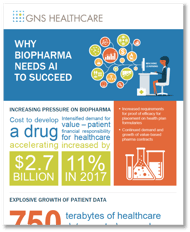
Interest in applying artificial intelligence and machine learning to healthcare has reached a pinnacle. Every day there are a slew of new articles and reports discussing the various ways that algorithms can transform the industry and there are many interesting technologies being developed and deployed—from digital health technologies that aim to make care delivery more patient-centric to machines that use image recognition to identify tumors before the human eye can see them.
A big area of potential growth for the use of AI is in precision medicine— the ability to customize the treatment patients receive based on their individual needs. According to a 2017 McKinsey report, using AI to advance precision medicine has the potential to save $2 trillion - $10 trillion globally1. Those savings would be a welcome sight, especially in the U.S. given the meteoric rise of health care costs combined with an aging population that will require more care.
Biopharma has a huge role to play in the achievement of precision medicine. We’ve previously explored how AI can impact drug discovery, but increasingly biopharma interest in AI has focused on how they can leverage innovative technologies to simplify and accelerate the clinical trial process. With costs of a successful trial heading toward $3 billion and an elapsed time of nearly a decade, it’s obvious that there is an opportunity to implement new approaches that will hopefully lead to much higher success rates.
It takes a village
It’s been 30-years since Phil S. Ensor of the Goodyear Tire and Rubber Company coined the term “functional silo syndrome” to describe how departments often operated as their own entities within an organization2. The truth is that cross-functional collaboration is still something that companies struggle with today. Many experts responsible for the success of clinical trials have realized that the key to increasing the probability of success (POS) of a trial begins in the pre-clinical phase—in the identification of novel biomarkers, drug targets, and molecules.
But to truly make this strategy success, it requires an interdisciplinary team. The computational experts need to be involved in the protocol design early on to make sure the right data is collected at the right time. Data scientists should be part of the collaboration to help develop the models that are being established. The computational teams must help create the algorithms that the biostatisticians apply to real world studies to try and understand patterns. Microbiologists and clinicians must then evaluate the results to ensure they are valid and make sense in real world scenarios.
Getting to the next level in drug development requires gaining buy-in and collecting different viewpoints from all stakeholders. It takes harnessing the brainpower from talented, multi-disciplinary professionals across the enterprise to successfully develop a drug and companies are now seeing that they must break down internal silos to make that happen.
Involving patients
The lifeblood of the clinical trial process is data, but the issue is no longer getting enough data, but getting the right data for the particular trial. One approach being used by some pharma companies is to collaborate with the patient community and begin dealing with individuals as more than just statistics. In addition to uncovering the molecular characteristics of patients, it’s important to engage with them to determine the things they are suffering from symptomatically. Reverse engineering from that point can help gain an understanding of the disease progression, what the drug should be targeting and how that information can integrate with existing treatments.
Patients are also becoming valuable endpoints in providing data that can be used in studies. In addition to information from EHRs, lab reports and clinician notes, many individuals are now using wearables and smartphones to track their health and provide real-time data on lifestyle changes, activity, and health outcomes. This type of non-invasive feedback is key in creating the longitudinal data that can be extremely valuable in uncovering insights.
The patient community today is very different from what it was years ago. Many patients today are willing participants and want to be involved in their own healthcare planning. Pharma companies shouldn’t hesitate to engage them early on for their input in exploratory questions.
Leveraging technology
To make sense of all the data that is feeding the process and develop insights that can lead to higher POS requires the use of enormous computing power. This allows researchers to analyze the data rather than bogging them down trying to gather and clean it.
In particular, certain types of AI can be particularly effective when it comes to identifying confounding factors. When an analysis delivers a result that appears odd, AI can evaluate the data that can help quickly and effectively weed out confounding factors. To significantly improve POS in clinical trials, researchers need the scale, speed and quantitative precision AI can provide because the data is so broad and the biology is so complex.
Combining talented professionals, leveraging new sources of data and stakeholder imput, and the computing power of Artificial Intelligence (AI) and causal learning can yield significant benefits in streamlining and accelerating the clinical trial process. If handled properly, approaches like these can create a true opportunity to improve the learning process.
Regardless of the tools, processes and technology pharma companies are using, success comes from a strategy that integrates elements of the entire organization and the patient community.

To learn more about how biopharma can leverage artificial intelligence to succeed, download our most recent infographic.
[1] McKinsey Global Institute. (2017). Artificial Intelligence: The Next Digital Frontier? McKinsey. Retrieved 07 12, 2018, from https://www.mckinsey.com/~/media/McKinsey/Industries/Advanced%20Electronics/Our%20Insights/How%20artificial%20intelligence%20can%20deliver%20real%20value%20to%20companies/MGI-Artificial-Intelligence-Discussion-paper.ashx
[2] Ensor, P. S. (1988, Spring). AME Target: 16. Retrieved 07 12, 2018, from http://www.ame.org/sites/default/files/documents/88q1a3.pdf

